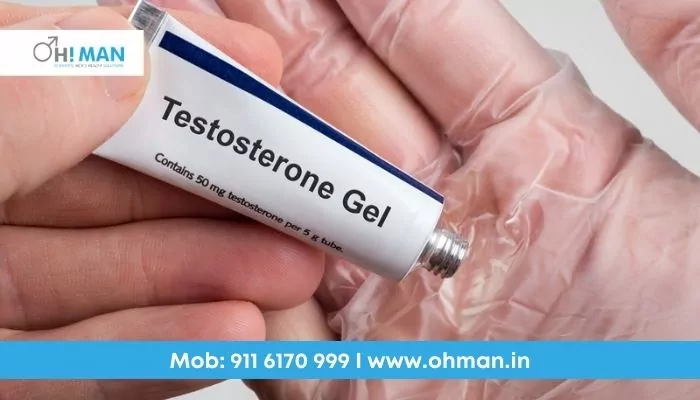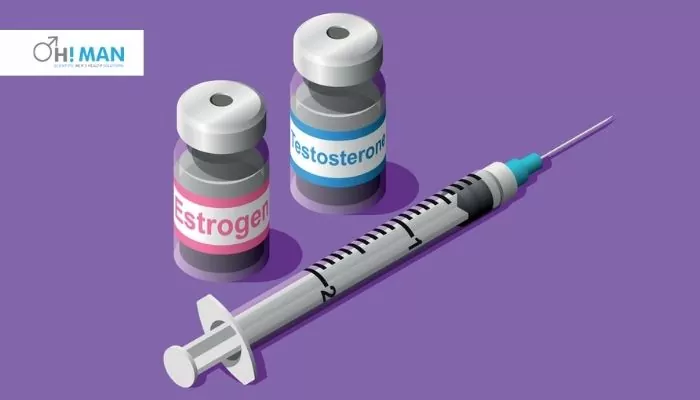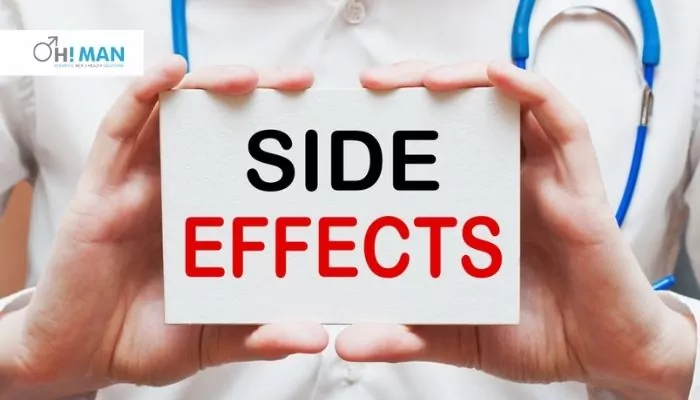Testosterone Replacement Therapy: Procedure, Cost & Risk Factors
Testosterone Replacement Therapy: Procedure, Cost & Risk Factors

Testosterone is a crucial component in a variety of bodily functions. These include bone and muscle health, cognitive function, blood cells and sperm development, and reproductive and sexual function for males. But, testosterone levels may decrease due to various reasons such as stress, ageing and certain medical conditions, including hypogonadism. In that case, To increase testosterone levels in body testosterone replacement therapy is used to fight the signs and symptoms of low testosterone.
Table of Content –
- What Is Testosterone Replacement Therapy?
- Impact On Men’s Health Due To Low Testosterone
- Testosterone Levels With Ageing
- Non-Medical Use Of Testosterone Therapy
- How Doctors Perform Testosterone Replacement Therapy?
- The Types Of Testosterone Replacement Therapy
- The Cost Of TRT Therapy in India
- The Risks Associated With Testosterone Replacement Therapy
- Bottom Line
- Frequently Asked Questions
What Is Testosterone Replacement Therapy?
It is an abbreviation used to describe testosterone replacement therapy, also known as androgen replacement therapy. It’s utilized to combat the low testosterone (T) levels due to age or illness.
It’s also becoming more and more popular for non-medical purposes such as:
- Boosting sexual performance
- getting more energy levels
- Building muscle mass to help the body build
Certain studies suggest that testosterone replacement therapy could help to achieve these objectives. However, there are a few caveats. Let’s look at what transpires to T amounts as you grow older and what you can expect from TRT therapy.
Impact On Men’s Health Due To Low Testosterone
- Modifications in sexual functions. This might include decreased sexual desire and less spontaneous erections like sleep and infertility.
- Changes in physical appearance. Physical changes can be observed, including increased body fat, decreased muscle strength and bulk, and decreased bone density. There might be breasts that are tender or swollen (gynecomastia) and loss of body hair are probable. Additionally, you may feel less energetic than you once did.
- Changes in emotions. Low testosterone can result in a decrease in self-confidence and motivation. You may feel depressed or sad or struggle with concentration or recalling information.
A few of these symptoms and signs may be due to other factors, like medications, including obstructive sleep apnea, thyroid issues, depression, and diabetes. Additionally, it’s also possible that the conditions can cause lower testosterone levels, which means the treatment could produce testosterone.
No treatment is currently suggested for men in the millions with low testosterone levels but shows no signs. Also, it has not been approved for treating males who are low in testosterone due to the ageing process.
A blood test can be used to detect the presence of low testosterone levels, and accordingly, the doctor can recommend the proper low testosterone treatment.
Testosterone Levels With Ageing
Testosterone levels usually peak around the early years of adolescence and then in the early years of adulthood. The testosterone level slowly drops as you get older, typically around 1 per cent per year after 30 to 40. For older men, it’s crucial to know the cause of a decline in testosterone levels is due to normal ageing or whether it’s due to an illness (hypogonadism).
Hypogonadism can hinder the capacity to produce normal testosterone levels because of problems with the testicles, or the pituitary gland, which controls the testicles. Testosterone replacement therapy or low testosterone treatment, which can take the form of pellets, patches, injections, gels, or patches, can alleviate the symptoms and signs of low testosterone levels in these men.
Non-Medical Use Of Testosterone Therapy
Several nations don’t allow individuals to purchase T products or supplement legally for treating TRT. So, a prescription for testosterone treatment supplements is necessary.
However, many people look for TRT for a variety of reasons that are not medical:
- Losing weight
- increasing energy levels
- Enhancing sexual drive or improving performance
- increasing endurance to perform sporting activities
- building up extra muscle mass to aid in bodybuilding
TRT has been proved to provide several of these advantages. For instance, a study found that it effectively increased the strength of muscles in older and middle-aged males.
However, TRT has only a few benefits for young males with healthy or higher T levels, and the risks could outweigh the advantages.
Furthermore, the use of TRT to gain an edge in sports is regarded as “doping” by many professional organizations, and many can consider it grounds for terminating the competition.

How Doctors Perform Testosterone Replacement Therapy?
Doctors prescribe TRT for men who suffer from hypogonadism. To make a definitive diagnosis, the blood tests must prove that the patient is lower in testosterone than 300 nanograms/deciliter (ng/dl). The patient must also exhibit fatigue, breast growth, and sexual dysfunction.
However, doctors don’t generally suggest TRT as the primary treatment for low testosterone levels, even for men who exhibit these signs.
If other medical conditions or drugs cause testosterone levels to decrease, doctors will typically treat the root of the problem before suggesting TRT.
TRT is available only through a prescription. Suppose a patient has symptoms that suggest an insufficient testosterone level. In that case, the physician will only issue a prescription after having a complete medical history and conducting lab and physical examinations.
Since hormone levels vary based on the level of activity, food, diet, and timing of the day, doctors generally conduct an examination of the blood before noon on the same day for two consecutive days. Sometimes, they may require imaging studies and other tests. The tests include the luteinizing hormone and follicle-stimulating hormone. So, this helps in identifying the root cause of the low testosterone levels.
There are many methods to perform testosterone replacement therapy, and the best choice will depend on your medical requirements and lifestyle. Some procedures require daily monitoring, while others can be carried out regularly.
The methods of testosterone therapy for men are:
- oral medication
- intramuscular injections
- transdermal patches
- topical creams
There’s also another form of TRT therapy, which involves applying the gums with testosterone twice every day.
The Types Of Testosterone Replacement Therapy
There are a variety of ways to administer testosterone for low testosterone treatment.
Injectable Testosterone Replacement Therapy
The injectable form of testosterone is a cheap and widely used kind of TRT. It is possible to get a short-acting treatment that involves taking a shot every one or two weeks, or long-acting therapy with the second shot occurs four weeks following the first, and the rest are separated by ten weeks. The frequency and dosage of treatment could differ according to the individual.
Doctors inject short-acting testosterone into the skin or muscles and long-acting shots to gluteal muscles.
TRT may cause changes in testosterone levels, which can impact levels of energy, libido and mood, and even the appearance of the tenderness of the breasts. So, this can be an ideal hormone replacement therapy for men.
Topical (transdermal)
Gels as well as creams frequent basis. Absorption in stages leads to more steady levels of testosterone in the blood.
However, those who use topical treatment should be aware of staying clear of skin-to-skin contact with others for at least six hours following application. It is essential to reduce the possibility of passing the drug onto another person’s skin since it can be hazardous for pregnant women and children.
Patches for topical use stick onto the skin and remain on the skin for 24 hours before reapplying. The drawback to patches is that they aren’t visually appealing and frequently cause skin irritations.
Patches for the buccal or cheek
In twelve hours, the person puts buccal patches over the upper teeth and produces testosterone. Comparatively to oral medication, patches are generally less harmful to the liver. However, they can result in headaches and mouth and gum irritation.
Implants or pellets of testosterone
Testosterone pellets are small plastic pellets that doctors under the skin implant. The implant is placed in the upper hip of a patient’s buttock. So, the pellets break down slowly and deliver TRT for 3 to 6 months.
Implants can be inserted in a minimal surgery performed in a hospital. Further, a surgeon makes a tiny cut before inserting the pellets inside the fat tissue underneath the skin, and the procedure is performed using local anesthesia.
Oral testosterone
Oral testosterone can be a rarer form of TRT, which is more costly and not as practical. The long-term use of testosterone can cause damage to the liver.
Many tablets also have warnings regarding the drug’s potential to cause stroke and hypertension. So, this is why only those unable to take other types of TRT can take testosterone via the mouth.
Intranasal Testosterone Replacement Therapy
The person applies the nasal testosterone gel to nasal tissue. They should apply it three times per day at intervals between six to eight hours and, in the best case, at the same times each day. Also, the most common responses to this therapy are migraines, nasal bleeding, nosebleeds, running nose and nasal pain.
The Cost Of TRT Therapy in India
The cost of TRT Therapy depends upon what kind of methods you are using in TRT. If you use Inactions, its price can range between 500 to 2000 Rs per month, depending on injection frequency. At the same time, the cost of oral medicine can range from 450 to 2000 rupees per month. In addition, don’t forget to add other medical expenses like testing, diagnosis and consultation fees that can increase the total price of treatment to 10000 Rs to 150000 Rs in some cases depending upon length and method of treatment.

The Risks Associated With Testosterone Replacement Therapy
Besides negative effects in the short term, TRT may also cause health problems. Those who suffer from the following ailments should not take TRT.
- high prostate-specific antigen levels can lead to Prostate cancer and person with high prostate- specific antigen should avoid TRT.
- high hemoglobin levels
- Untreated and severe sleep apnea, if not treated, can be fatal.
- thrombophilia
- Extreme lower urinary tract symptoms
- congestive heart failure
- recent stroke or heart attack
The report also says that the treatment is unsuitable for males who want to have a baby soon.
Males 40 years old or older, preadolescents, and people with epilepsy or migraine might require particular care.
The Adverse side -effects associated with taking testosterone are:
- Itching, rashes, and acne
- male pattern hair loss
- hair loss or excessive hair growth
- anxiety
- bladder irritability
- priapism
- deep vein thrombosis
- aggression and anger
- the breast, or swelling of the breasts ( gynecomastia)
- High blood pressure
- the size of the prostate increases
- reduced production of sperm
- Prostate cancer is getting worse
- shrinkage of the tests
- Red blood cells have a high count can result in blood clots
- liver dysfunction
Bottom Line
TRT has been used for a long time as an option to treat patients who suffer from hypogonadism or other conditions that are related to reduced T production. However, the benefits for those who don’t have an underlying medical condition aren’t as obvious despite all the hype.
Consult your physician before you start taking any T supplements or medicines. Additionally, they will be able to help you decide the goals you want to achieve with TRT are realistic and safe.
It’s also essential to be observed by an expert medical doctor when you are taking T supplements to be aware of any negative side effects in the course of treatment. Consult our experts for further questions and end your doubts about TRT Visit ohman.in and book your consultancy now.
Frequently Asked Questions
1. What are the side effects of testosterone replacement therapy?
The side effects are:
- Acne or very greasy skin.
- Mild retention of fluid.
- Prostate tissue stimulation, accompanied by increased urination indications such as a reduced stream or frequency.
- Risk of having prostatic abnormalities
- Breast enlargement
- High risk of blood costs
2. Is testosterone replacement therapy a good idea?
There is no evidence that TRT would recover your physical health or sexual performance to those of your youth, prolong your life, reduce the risk of heart disease or prostate cancer, or enhance your memory or mental acuity. Make no such assumptions while seeking TRT treatment.
3. How long can you be on testosterone replacement therapy?
Almost all men may reach physiological testosterone levels with medical assistance within three to four months of therapy. Further, the response, meanwhile, varies according to basal hormone levels and the length and amount of administration. Additionally, the TRT is a long-term, if not permanent, treatment. With most chronic diseases, discontinuing the medication may result in the recurrence of symptoms as testosterone levels drop beyond adequate levels.
4. Is TRT covered by insurance?
Several health insurance companies will pay the bulk of the cost of testosterone therapy for males if they can establish a medical need.
5. What is the cheapest form of testosterone replacement therapy?
Without insurance, testosterone replacement treatment by injections is the least costly option. Pellets—slow-release drugs placed under the skin—may vary in size depending on your level.
6. What is the average testosterone level by age?
Here is the average testosterone level as per age:
- 7–10 years old: 1.80 to 5.68
- 13–17 years old: 208.08 to 496.58
- 19 years and older: 265–923



